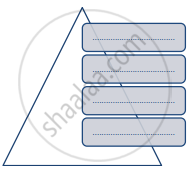Advertisements
Advertisements
Questions
Status of women in India during Early Vedic Period
Write a short note on the following:
Status of Women in the Early Vedic Period
Solution
- Indian women enjoyed a comparatively high status during the early Vedic period as compared to the Later Vedic period.
- They had access to Vedic education. They were entitled to the upanayana (thread) ceremony which enabled them entry into the Gurukul system of education.
- Educated women were divided into two categories: Sadyavadhu and Brahmavadinis. Sadyavadhu pursued their education until they were married while Brahmavadinis never married and continued studying and imparting education throughout life.
- Women were considered as useful and productive members of society.
- They could participate in social assemblies (vidath). They were also permitted to choose their life partners for marriage.
- They did not have equal rights with their male counterparts as regards social and legal aspects. They did not possess the right to property.
- Vedas and Vedangas were taught to women too, but later became limited to religious songs and poems necessary for rituals.
- Some notable Vedic and Upanishadic women scholars were Apala, Indrani, Ghosha, Lopamudra, Gargi and Maitreyi.
RELATED QUESTIONS
What was the nature of education during the Early Vedic period?
Monks in Buddhist monasteries were called ______.
Correct the underlined word and complete the statement.
Elementary education was imparted in Khanqahs during the medieval period.
Write short notes.
Education during the Early Vedic period.
Write short notes.
Status of women during the Medieval period.
Write differences.
Status of Women in the Early Vedic Period and Later Vedic Period
Write differences.
Education in the Ancient Period and Colonial period in Indian society
Buddhism spread to several parts of India and beyond.
The sacred book of Jews is ______.
Maktabs were centres of ______.
Correct the underlined word and complete the statement.
Shia and Sunni are sects in Judaism.
Correct the underlined word and complete the statement.
Maktabs provide theological education.
Status of women in India during Later Vedic Period.
Write differences.
Brahmacharyashram and Grihasthashram
Write differences.
Zoroastrianism and Islam
Explain the following concept with examples.
Ashramvyavastha
Explain the following concept with example.
Madrasa
Explain the following concept with example.
Sangham Period
Complete the concept map.
| Pillars of Islam | |
| a. | |
| b. | |
| c. | |
| d. |
Complete the concept map.
Caste hierarchy

Complete the concept map.
Ashramvyavastha

State whether the following statement are true or false with reason.
Religious teachings have no influence on human behaviour.
State whether the following statement are true or false with reason.
Buddhism spread to several parts of India and beyond.
Correct the incorrect pair and rewrite it.
| I | Ahura Mazda – Judaism |
| II | Vardhamana Mahavir – Jainism |
| III | Guru Nanak Dev – Sikhism |
| IV | Jesus Christ – Christianity |
| V | Brahmin – Priest |
Match the Columns:
| Column 'A' | Column 'B' |
| (i) Dharma | (a) refers to acquisition of wealth through the path of righteousness through hard work. |
| (ii) Artha | (b) ultimate goal of salvation from the cycle of birth and rebirth |
| (iii) Kama | (c) doing one’s duties by following the path of righteousness, without the expectation of a reward |
| (iv) Moksha | (d) sensuous pleasure or sexual union through the path of righteousness |
Correct the incorrect pair and rewrite it.
Differentiate between Christianity and Islam.
Correct the underlined words and complete the sentence.
Sikhism was founded by Guru Govind Singh.
In the medieval period, elementary education was imparted in ______.
Correct the incorrect pair and rewrite it:
Correct the underlined word, complete and rewrite the statement:
The ultimate aim of Hindus is Artha.
